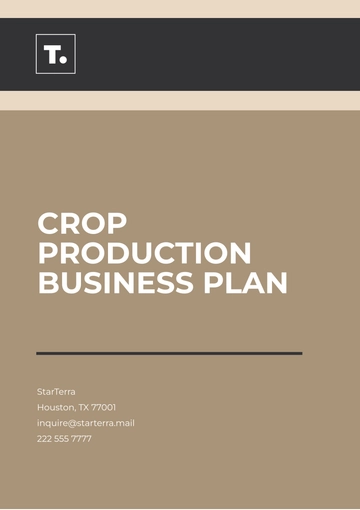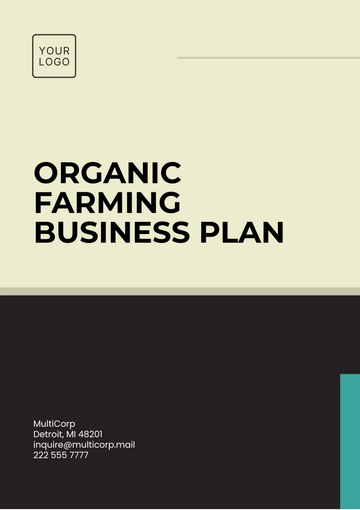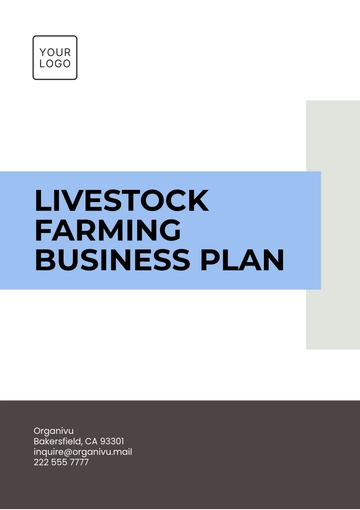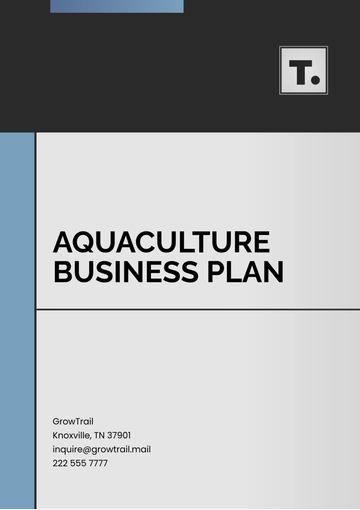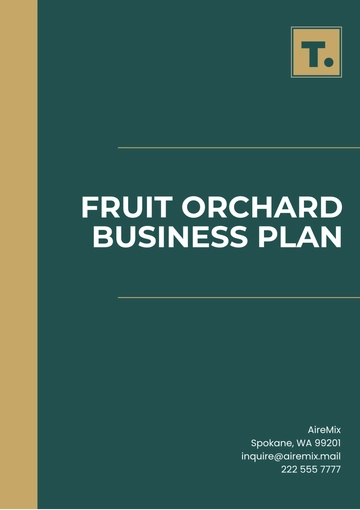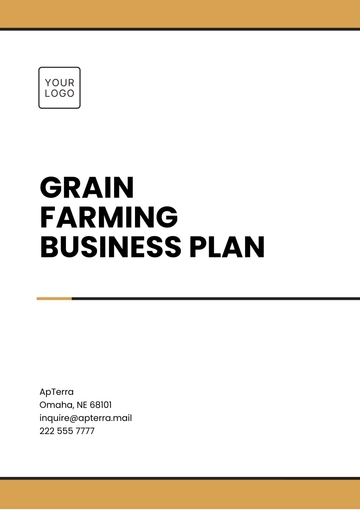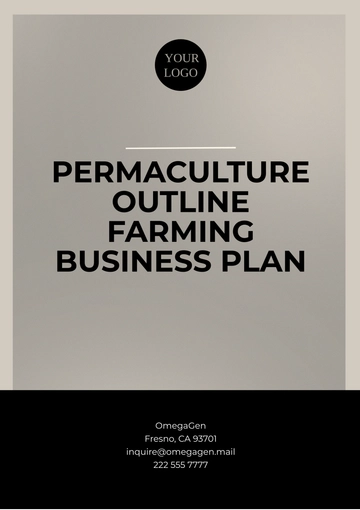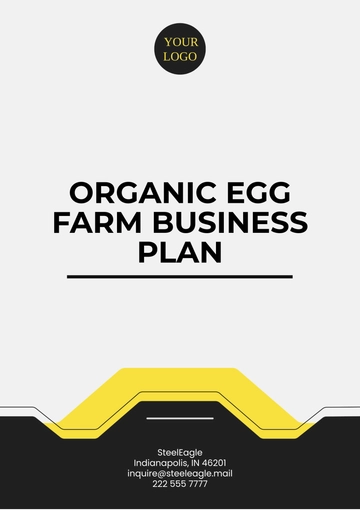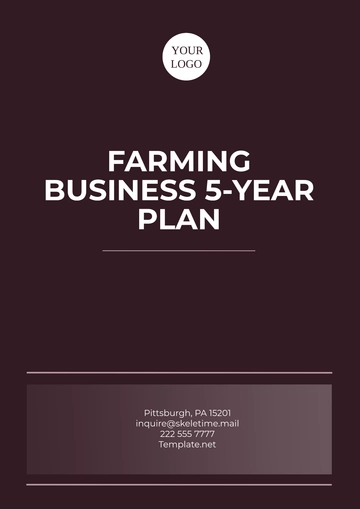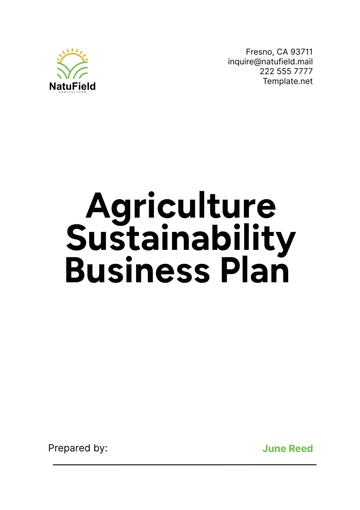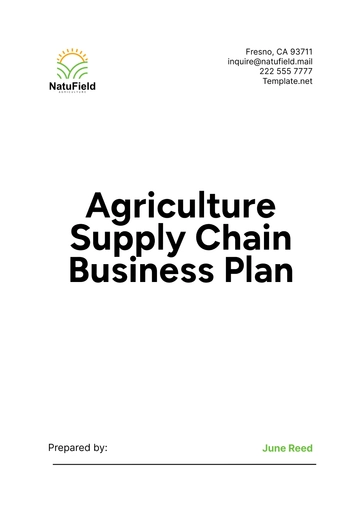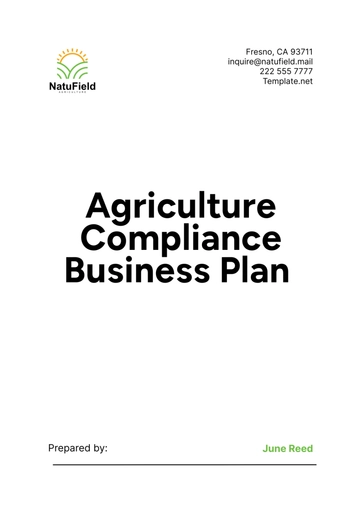Free Agriculture Sustainability Business Plan
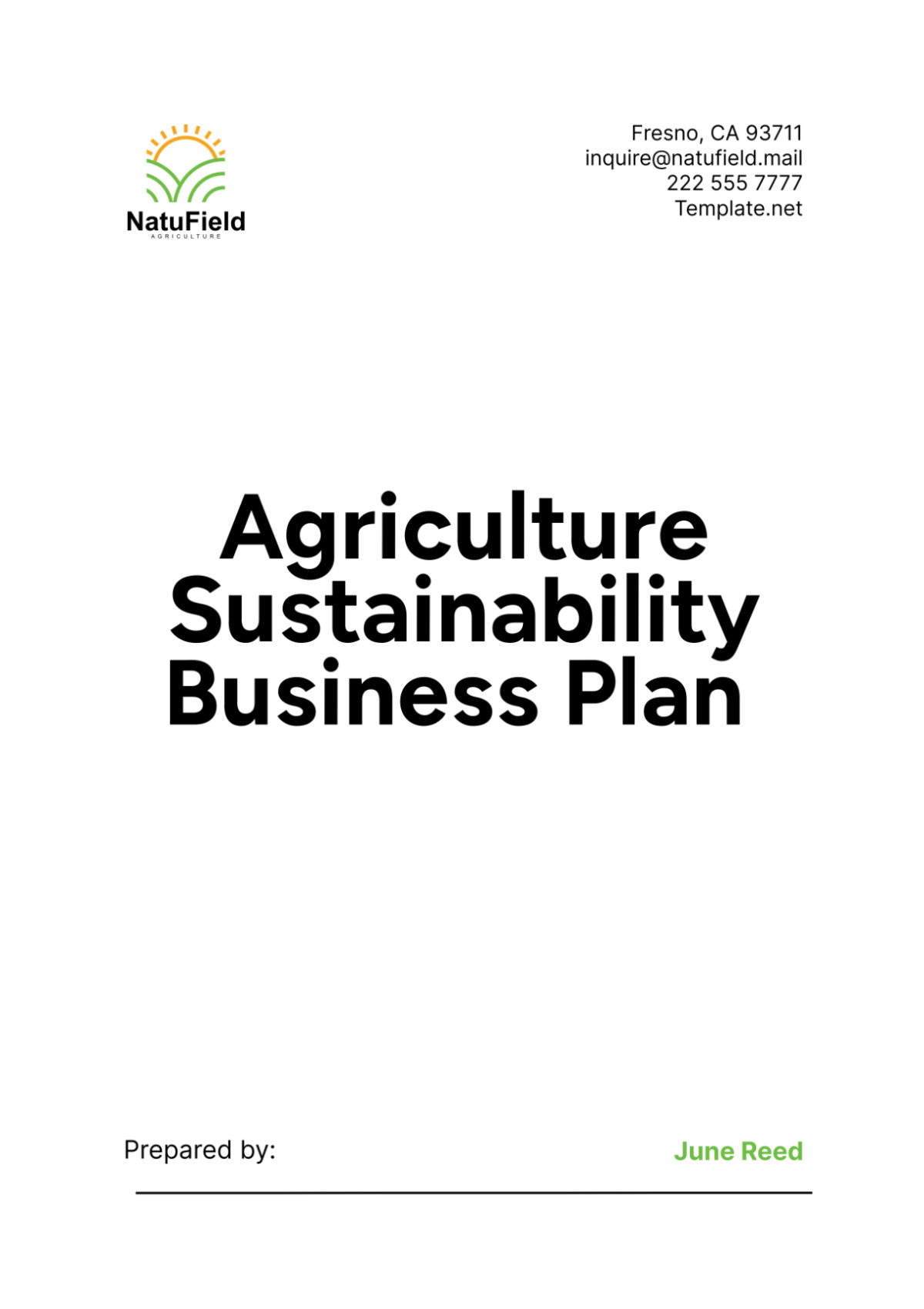
I. Executive Summary
This business plan outlines the strategies and objectives for promoting sustainable agricultural practices within [Your Company Name]. The plan includes detailed sections on the current market landscape, sustainable practices, financial projections, and implementation strategies.
A. Introduction
Agricultural sustainability is crucial for the long-term viability of farming practices and the overall health of our planet. At [Your Company Name], we are committed to integrating sustainable practices into our agricultural operations to ensure environmental stewardship, economic profitability, and social responsibility. This business plan outlines our strategies for implementing sustainable agriculture practices, improving our market position, and achieving financial sustainability.
B. Mission Statement
Our mission is to lead the agricultural industry in sustainable practices by utilizing innovative techniques that preserve natural resources, promote biodiversity, and ensure food security for future generations. We aim to be a model for sustainable agriculture, balancing ecological, economic, and social priorities.
C. Vision Statement
Our vision is to create a sustainable agricultural system that enhances the health of our environment, supports local communities, and provides high-quality, nutritious food. We envision a future where farming practices are regenerative, resilient, and profitable, contributing to the well-being of people and the planet.
D. Business Objectives
To implement and maintain sustainable farming practices that improve soil health, conserve water, and enhance biodiversity.
To increase the profitability of our agricultural operations through efficient resource use and innovative marketing strategies.
To foster a positive impact on local communities by providing education, employment opportunities, and support for local food systems.
To achieve certification in sustainable agriculture standards and maintain compliance with environmental regulations.
E. Summary of Sustainable Practices
We will focus on key areas such as soil health management, water conservation, pest and disease management, biodiversity enhancement, and renewable energy use. By adopting these practices, we aim to reduce our environmental footprint, increase farm productivity, and improve the quality of our products.
II. Market Analysis
A. Industry Overview
The agricultural industry is undergoing significant transformation due to increasing awareness of environmental issues, changing consumer preferences, and advancements in technology. Sustainable agriculture is becoming a critical focus, driven by the need to address climate change, soil degradation, and water scarcity. The global market for sustainable agriculture is expanding, with a growing demand for organic products, regenerative farming techniques, and environmentally friendly practices.
B. Market Trends
Organic Farming: The demand for organic products continues to rise as consumers become more health-conscious and environmentally aware. This trend is supported by increasing organic farmland and certification programs.
Technological Advancements: Precision agriculture, data analytics, and automation are revolutionizing farming practices, enabling more efficient resource use and better crop management.
Consumer Preferences: There is a growing preference for locally sourced, sustainably produced food. Consumers are willing to pay a premium for products that are environmentally friendly and socially responsible.
Regulatory Changes: Governments and international bodies are implementing policies and regulations to promote sustainable agriculture, including subsidies, tax incentives, and certification programs.
C. Target Market
Our target market includes health-conscious consumers, environmentally aware individuals, and organizations seeking sustainable food sources. We will focus on local and regional markets, leveraging our proximity to urban centers to provide fresh, high-quality produce. Additionally, we will target niche markets such as organic food stores, farmers' markets, and farm-to-table restaurants.
D. Competitive Analysis
We face competition from conventional farmers, organic producers, and other sustainable agriculture enterprises. Our competitive advantage lies in our comprehensive approach to sustainability, which includes innovative farming techniques, efficient resource management, and strong community engagement. We will differentiate ourselves by offering high-quality products, transparent practices, and a commitment to environmental stewardship.
E. SWOT Analysis
Strengths | Weaknesses |
|---|---|
Innovative sustainable practices | Higher initial investment costs |
Strong community relationships | Limited market reach initially |
Experienced and dedicated team | Need for continuous education |
Access to advanced technology | Challenges in changing consumer habits |
Opportunities | Threats |
|---|---|
Growing demand for organic products | Climate change impacts |
Technological advancements | Regulatory changes |
Expansion into new markets | Market competition |
Government incentives for sustainability | Economic fluctuations |
III. Sustainable Agriculture Practices
A. Soil Health Management
Crop Rotation: Crop rotation involves alternating the types of crops grown in a particular area from one season to the next. This practice helps to break pest and disease cycles, improve soil structure, and enhance nutrient availability. At [Your Company Name], we will implement a diverse crop rotation plan that includes legumes, grains, and cover crops to promote soil fertility and reduce dependency on synthetic fertilizers.
Cover Cropping: Cover crops, such as clover, rye, and vetch, will be planted during off-season periods to protect and enrich the soil. These crops prevent soil erosion, improve soil organic matter, and enhance water infiltration. Cover cropping also provides habitat for beneficial insects and microorganisms, contributing to a balanced ecosystem.
Organic Amendments: We will use organic amendments like compost, manure, and green manure to improve soil fertility and structure. These amendments increase soil organic matter, enhance microbial activity, and provide essential nutrients to crops. By using organic inputs, we will reduce the reliance on chemical fertilizers and promote long-term soil health.
B. Water Conservation Techniques
Drip Irrigation: Drip irrigation systems deliver water directly to the root zone of plants, minimizing water loss through evaporation and runoff. This method ensures efficient water use and reduces the overall water consumption. We will install drip irrigation systems across our fields to optimize water usage and enhance crop yield.
Rainwater Harvesting: Rainwater harvesting involves collecting and storing rainwater for agricultural use. This practice helps to reduce dependency on groundwater and municipal water sources. We will implement rainwater harvesting systems to capture and store rainwater for irrigation, ensuring a sustainable water supply throughout the growing season.
Efficient Water Use Practices: We will adopt various practices to ensure efficient water use, such as mulching, soil moisture monitoring, and scheduling irrigation based on crop needs. Mulching helps to retain soil moisture, reduce weed growth, and improve soil health. Soil moisture sensors will be used to monitor soil moisture levels and optimize irrigation schedules, ensuring that crops receive adequate water without wastage.
C. Pest and Disease Management
Integrated Pest Management (IPM): Integrated Pest Management (IPM) is a holistic approach to pest control that combines biological, cultural, physical, and chemical methods. IPM focuses on preventing pest problems through crop rotation, resistant varieties, and habitat management. When necessary, biological control agents and targeted chemical treatments are used to manage pest populations. At [Your Company Name], we will implement IPM strategies to minimize the use of synthetic pesticides and promote a balanced ecosystem.
Biological Control Methods: Biological control involves using natural predators, parasites, and pathogens to manage pest populations. This method is environmentally friendly and reduces the reliance on chemical pesticides. We will introduce beneficial insects, such as ladybugs and parasitic wasps, to control pests and maintain ecological balance.
Organic Pesticides: When pest pressure is high, we will use organic pesticides derived from natural sources, such as neem oil, pyrethrin, and diatomaceous earth. These pesticides are less harmful to non-target organisms and degrade more quickly in the environment. By using organic pesticides, we will protect our crops while minimizing environmental impact.
D. Biodiversity Enhancement
Agroforestry: Agroforestry integrates trees and shrubs into agricultural landscapes, providing multiple benefits such as improved soil health, increased biodiversity, and enhanced carbon sequestration. We will implement agroforestry practices by planting native tree species along field margins, creating windbreaks, and establishing silvopasture systems.
Habitat Conservation: We will conserve and restore natural habitats within and around our farm to support wildlife and promote biodiversity. This includes preserving wetlands, creating buffer zones along waterways, and planting native vegetation. Habitat conservation helps to protect endangered species, enhance ecosystem services, and improve landscape resilience.
Pollinator Support: Pollinators, such as bees, butterflies, and other insects, play a crucial role in crop production. We will create and maintain pollinator-friendly habitats by planting diverse flowering species, reducing pesticide use, and providing nesting sites. By supporting pollinators, we will enhance crop yields and contribute to biodiversity conservation.
E. Renewable Energy Use
Solar Power: We will install solar panels to generate renewable energy for our farm operations. Solar power provides a clean and sustainable energy source, reducing our carbon footprint and lowering energy costs. Solar installations will be used to power irrigation systems, farm machinery, and processing facilities.
Wind Power: Wind turbines will be installed to harness wind energy for our farm. Wind power is a reliable and sustainable energy source that can supplement our energy needs. By integrating wind power into our energy mix, we will reduce our reliance on fossil fuels and contribute to renewable energy development.
Bioenergy: Bioenergy involves using organic materials, such as crop residues, manure, and food waste, to produce energy. We will implement bioenergy systems, such as anaerobic digesters and biomass boilers, to convert waste materials into biogas and biochar. These systems will provide renewable energy for our farm and contribute to waste management.
IV. Business Operations
A. Production Plan
Crop Selection: Our crop selection will focus on a diverse range of high-value, nutrient-rich crops that are well-suited to our local climate and soil conditions. This includes vegetables, fruits, grains, and legumes. We will prioritize crops that are in demand in the local market and have a high potential for organic certification.
Production Schedule: The production schedule will be planned to optimize planting and harvesting times, ensuring a continuous supply of fresh produce throughout the year. We will use season extension techniques, such as high tunnels and greenhouses, to extend the growing season and increase production capacity.
Sustainable Farming Practices: We will implement the sustainable farming practices outlined in section III, including crop rotation, cover cropping, drip irrigation, IPM, and agroforestry. These practices will enhance soil health, conserve water, manage pests and diseases, and promote biodiversity.
B. Supply Chain Management
Supplier Relationships: We will establish strong relationships with suppliers of organic seeds, compost, and other inputs. This includes partnering with local businesses and cooperatives to support the local economy and ensure a reliable supply of high-quality materials.
Logistics and Distribution: Efficient logistics and distribution are critical to delivering fresh produce to our customers. We will develop a logistics plan that includes transportation, storage, and delivery schedules. This plan will optimize routes, reduce transportation costs, and ensure timely delivery.
Inventory Management: Effective inventory management will help us to minimize waste and ensure a consistent supply of products. We will use inventory management software to track stock levels, monitor product quality, and manage order fulfillment.
C. Quality Control
Certification and Compliance: We will pursue certification in organic and sustainable agriculture standards, such as USDA Organic and GlobalG.A.P. Compliance with these standards will ensure that our products meet stringent quality and sustainability criteria. Regular audits and inspections will be conducted to maintain certification.
Product Testing: Product testing will be conducted at various stages of production to ensure quality and safety. This includes soil testing, water quality analysis, and residue testing for pesticides and contaminants. We will work with accredited laboratories to perform these tests and ensure compliance with regulatory standards.
Customer Feedback: Customer feedback is essential for continuous improvement. We will implement a system for collecting and analyzing customer feedback, including surveys, reviews, and direct communication. This feedback will be used to improve product quality, enhance customer satisfaction, and identify areas for innovation.
D. Marketing and Sales
Marketing Strategy: Our marketing strategy will focus on promoting the benefits of sustainable agriculture and highlighting our commitment to environmental stewardship. This includes branding, advertising, social media, and community engagement. We will emphasize the quality, freshness, and sustainability of our products.
Sales Channels: We will utilize multiple sales channels to reach our target market, including farmers' markets, organic food stores, online platforms, and direct-to-consumer sales. We will also explore partnerships with restaurants, schools, and institutions that prioritize sustainable food sourcing.
Pricing Strategy: Our pricing strategy will reflect the value of our sustainably produced products while remaining competitive in the market. We will conduct market research to determine optimal pricing and consider factors such as production costs, market demand, and customer willingness to pay.
E. Human Resources
Staffing Plan: Our staffing plan will ensure that we have the necessary workforce to support our sustainable agriculture operations. This includes hiring skilled workers for production, quality control, marketing, and sales. We will provide training and development opportunities to enhance employee skills and knowledge.
Training and Development: Ongoing training and development are essential for maintaining high standards of sustainability and productivity. We will offer training programs on sustainable farming practices, quality control, safety, and customer service. Employees will have access to workshops, seminars, and online courses.
Employee Engagement: Employee engagement is critical for fostering a positive work environment and achieving our business objectives. We will implement strategies to enhance employee morale, motivation, and job satisfaction. This includes regular communication, recognition programs, and opportunities for career advancement.
V. Financial Plan
A. Financial Projections
Revenue Forecast: Our revenue forecast is based on projected sales volumes, pricing strategies, and market demand. We anticipate steady growth in revenue as we expand our production capacity and market reach. Detailed revenue projections will be provided for the next five years.
Expense Budget: The expense budget includes costs associated with production, marketing, distribution, and administration. We will carefully manage expenses to ensure financial sustainability while investing in necessary resources and infrastructure. Detailed expense projections will be provided for the next five years.
Profitability Analysis: Profitability analysis will be conducted to assess the financial viability of our sustainable agriculture operations. This includes calculating gross margins, net profit margins, and return on investment. We aim to achieve profitability within the first three years of operation.
B. Funding Requirements
Initial Capital: Initial capital will be required to cover startup costs, including land acquisition, equipment purchase, infrastructure development, and initial working capital. We will seek funding from various sources, including loans, grants, and investor contributions.
Working Capital: Working capital is essential for managing day-to-day operations and ensuring liquidity. This includes funds for purchasing inputs, paying wages, and covering operating expenses. We will maintain an adequate working capital reserve to support our business activities.
Funding Sources: We will explore multiple funding sources to secure the necessary capital for our sustainable agriculture operations. This includes government grants, agricultural subsidies, bank loans, and private investors. We will also consider crowdfunding and community-supported agriculture (CSA) models.
C. Financial Management
Financial Reporting: Regular financial reporting is essential for monitoring our financial performance and making informed decisions. We will implement an accounting system to track revenues, expenses, and cash flow. Financial reports will be generated on a monthly, quarterly, and annual basis.
Budgeting and Forecasting: Budgeting and forecasting will be conducted to plan and allocate resources effectively. This includes preparing annual budgets, projecting future financial performance, and adjusting plans based on actual results. We will use financial forecasting tools to support our decision-making process.
Risk Management: Risk management strategies will be implemented to mitigate financial risks and ensure business continuity. This includes diversifying revenue streams, maintaining adequate insurance coverage, and establishing contingency plans for unforeseen events. We will regularly review and update our risk management plan.
VI. Risk Management
A. Risk Assessment
Identification of Risks:
We will identify potential risks that could impact our sustainable agriculture operations. These risks include environmental factors (e.g., extreme weather events, climate change), market risks (e.g., price fluctuations, demand variability), operational risks (e.g., equipment failure, labor shortages), and financial risks (e.g., funding shortfalls, cash flow issues).
Risk Analysis:
A detailed risk analysis will be conducted to evaluate the likelihood and impact of each identified risk. This analysis will help prioritize risks and allocate resources for mitigation. The following table summarizes our risk analysis:
Risk Category | Risk Description | Likelihood | Impact | Mitigation Strategy |
|---|---|---|---|---|
Environmental | Drought, flooding, pest infestations | High | Severe | Implement irrigation, pest management systems |
Market | Price volatility, changing consumer preferences | Medium | Moderate | Diversify product range, establish contracts |
Operational | Equipment breakdown, labor shortages | Medium | High | Regular maintenance, workforce training |
Financial | Insufficient funding, cash flow problems | Low | High | Secure diverse funding sources, financial planning |
B. Mitigation Strategies
Environmental Risks: To mitigate environmental risks, we will adopt climate-resilient farming practices, such as soil conservation, water management, and integrated pest management. These practices will help minimize the impact of extreme weather events and pest infestations.
Market Risks: We will diversify our product range to reduce dependency on a single market segment. Establishing contracts with buyers and participating in farmers' markets will help stabilize prices and demand. Additionally, we will monitor market trends to adapt our offerings accordingly.
Operational Risks: Regular maintenance of equipment and infrastructure will minimize the risk of breakdowns. We will invest in training and development programs to ensure a skilled and reliable workforce. Contingency plans will be developed to address potential labor shortages.
Financial Risks: We will secure funding from multiple sources, including loans, grants, and investor contributions, to ensure financial stability. Robust financial planning and cash flow management will be implemented to mitigate the risk of funding shortfalls.
C. Emergency Response Plan
Preparedness: An emergency response plan will be developed to address potential crises, such as natural disasters, equipment failures, and health emergencies. This plan will outline the roles and responsibilities of employees, communication protocols, and emergency contacts.
Response: In the event of an emergency, immediate action will be taken to protect employees, assets, and the environment. Emergency drills and training sessions will be conducted regularly to ensure preparedness.
Recovery: Post-emergency recovery efforts will focus on restoring normal operations and minimizing disruption. This includes assessing damage, repairing infrastructure, and providing support to affected employees.
VII. Sustainability Metrics and Reporting
A. Sustainability Metrics
Environmental Metrics: We will track key environmental metrics to measure our impact and progress towards sustainability goals. These metrics include water usage, soil health, biodiversity, and carbon footprint. The following table outlines our environmental metrics:
Metric | Measurement Unit | Baseline Value | Target Value | Monitoring Frequency |
|---|---|---|---|---|
Water Usage | Gallons per acre | 10,000 | 8,000 | Monthly |
Soil Health | Soil Organic Matter (%) | 2.5 | 4.0 | Annually |
Biodiversity | Number of species | 15 | 25 | Quarterly |
Carbon Footprint | CO2e emissions (tons) | 50 | 30 | Annually |
Social Metrics: Social metrics will assess the impact of our operations on the community and workforce. These metrics include employee satisfaction, community engagement, and educational outreach.
Metric | Measurement Unit | Baseline Value | Target Value | Monitoring Frequency |
|---|---|---|---|---|
Employee Satisfaction | Satisfaction Score | 70 | 85 | Annually |
Community Engagement | Number of events | 5 | 10 | Annually |
Educational Outreach | Number of workshops | 2 | 6 | Annually |
Economic Metrics: Economic metrics will evaluate the financial performance and sustainability of our business. These metrics include revenue growth, profit margins, and return on investment.
Metric | Measurement Unit | Baseline Value | Target Value | Monitoring Frequency |
|---|---|---|---|---|
Revenue Growth | Percentage (%) | 5 | 15 | Annually |
Profit Margins | Percentage (%) | 10 | 20 | Annually |
Return on Investment | ROI (%) | 8 | 12 | Annually |
B. Data Collection and Analysis
Data Collection Methods: We will use various methods to collect data on sustainability metrics, including field measurements, surveys, and monitoring systems. Data will be collected regularly to ensure accuracy and relevance.
Data Analysis Tools: Data analysis tools, such as spreadsheets, statistical software, and sustainability management platforms, will be used to analyze and interpret the collected data. These tools will help identify trends, measure progress, and inform decision-making.
Reporting Framework: A reporting framework will be established to communicate our sustainability performance to stakeholders. This includes annual sustainability reports, progress updates, and performance dashboards. Reports will be transparent, comprehensive, and aligned with recognized sustainability standards.
VIII. Technology and Innovation
A. Technological Advancements
Precision Agriculture:
We will adopt precision agriculture technologies to enhance farming efficiency and productivity. This includes GPS-guided equipment, remote sensing, and data analytics. Precision agriculture will help optimize resource use, improve crop yields, and reduce environmental impact.
Smart Irrigation Systems:
Smart irrigation systems, such as drip irrigation and automated sprinklers, will be implemented to conserve water and improve irrigation efficiency. These systems will use sensors and weather data to deliver precise amounts of water to crops.
Renewable Energy:
We will explore the use of renewable energy sources, such as solar and wind power, to reduce our carbon footprint and enhance energy sustainability. Renewable energy systems will be integrated into our operations to power equipment and facilities.
B. Research and Development
Innovative Practices:
Research and development (R&D) efforts will focus on developing and testing innovative sustainable farming practices. This includes exploring new crop varieties, soil amendments, and pest management techniques.
Collaborations:
We will collaborate with research institutions, universities, and industry partners to advance our R&D initiatives. Collaborative projects will help us stay at the forefront of agricultural innovation and leverage external expertise.
Funding for R&D:
Funding for R&D will be secured through grants, partnerships, and reinvestment of profits. A dedicated R&D budget will support ongoing research projects and the development of new technologies.
C. Adoption of Best Practices
Benchmarking:
We will benchmark our practices against industry standards and best practices to ensure continuous improvement. Regular benchmarking exercises will help identify areas for enhancement and innovation.
Knowledge Sharing:
Knowledge sharing initiatives will be implemented to disseminate best practices across our organization. This includes training sessions, workshops, and internal communication channels.
Continuous Improvement:
A culture of continuous improvement will be fostered to encourage innovation and excellence. Employees will be empowered to suggest improvements and participate in problem-solving initiatives.
IX. Community and Stakeholder Engagement
A. Community Engagement
Local Partnerships:
We will build partnerships with local organizations, schools, and community groups to support community development and engagement. These partnerships will promote sustainable agriculture and enhance our social impact.
Community Programs:
Community programs, such as farm tours, educational workshops, and volunteer opportunities, will be organized to engage the community and raise awareness about sustainable agriculture.
Feedback Mechanisms:
Feedback mechanisms, such as surveys and community meetings, will be established to gather input from the community. This feedback will help us address community needs and improve our operations.
B. Stakeholder Communication
Transparency:
Transparent communication with stakeholders is essential for building trust and credibility. We will provide regular updates on our sustainability performance, business operations, and community impact.
Engagement Strategies:
Engagement strategies will include newsletters, social media, and stakeholder meetings. These channels will facilitate open dialogue and collaboration with stakeholders.
Partnerships:
Strategic partnerships with NGOs, industry associations, and government agencies will be pursued to advance our sustainability goals and expand our impact. These partnerships will provide access to resources, expertise, and networks.
C. Corporate Social Responsibility (CSR)
CSR Initiatives:
Our CSR initiatives will focus on addressing social and environmental issues relevant to our business and community. This includes supporting local food banks, participating in reforestation projects, and promoting sustainable agriculture education.
Employee Involvement:
Employees will be encouraged to participate in CSR activities through volunteer programs and company-sponsored events. Employee involvement in CSR initiatives will enhance team morale and contribute to our social impact.
Impact Assessment:
Regular assessments of our CSR initiatives will be conducted to measure their effectiveness and impact. These assessments will inform the development of future CSR strategies and programs.
X. Implementation Timeline
A. Phased Approach
Phase | Duration | Key Activities |
|---|---|---|
Phase 1: Planning and Preparation | Months 1-6 |
|
Phase 2: Pilot Projects | Months 7-12 |
|
Phase 3: Full-scale Implementation | Months 13-24 |
|
B. Milestones and Deliverables
Key Milestones | Expected Completion Date | Deliverables |
|---|---|---|
Completion of initial assessment and plan | Month 6 | Detailed implementation plan and timeline |
Successful completion of pilot projects | Month 12 | Pilot project reports and evaluation summaries |
Full-scale implementation of practices and technologies | Month 24 | Regular progress reports and performance dashboards |
C. Monitoring and Evaluation
Monitoring Activities | Frequency | Responsible Parties | Performance Indicators |
|---|---|---|---|
Regular reviews and audits | Quarterly | Internal audit team | Compliance with implementation plan |
Performance measurement and tracking | Monthly | Sustainability team | Alignment with sustainability metrics and goals |
Continuous improvement feedback sessions | Bi-Annually | Management and staff | Incorporation of feedback into ongoing efforts |
D. Communication Plan
Communication Activities | Target Audience | Frequency | Channels |
|---|---|---|---|
Internal updates | Employees | Monthly | Meetings, newsletters, intranet |
External updates | Stakeholders | Quarterly | Reports, stakeholder meetings |
Celebrating achievements and milestones | Employees, Stakeholders | As milestones occur | Company events, press releases |
- 100% Customizable, free editor
- Access 1 Million+ Templates, photo’s & graphics
- Download or share as a template
- Click and replace photos, graphics, text, backgrounds
- Resize, crop, AI write & more
- Access advanced editor
Develop sustainable business strategies with Template.net's customizable and editable Agriculture Sustainability Business Plan Template. Use the AI Editor Tool for detailed and effective planning. This user-friendly template promotes sustainable practices, enhancing environmental responsibility and long-term success in your agricultural business.
You may also like
- One Page Business Plan
- Coffee Shop Business Plan
- Restaurant Business Plan
- Food Business Plan
- Real Estate Business Plan
- Executive Summary Business Plan
- Cover Page Business Plan
- Nonprofit Business Plan
- Daycare Business Plan
- Construction Business Plan
- Startup Business Plan
- Medical Business Plan
- Bakery Business Plan
- Service Plan
- Hotel Business Plan
- Catering Business Plan
- School Business Plan
- Healthcare Business Plan
- Transportation Plan
- Sports Plan
- Car Wash Business Plan
- Salon Business Plan
- Clothing Business Plan
- Farming Business Plan
- Boutique Plan


